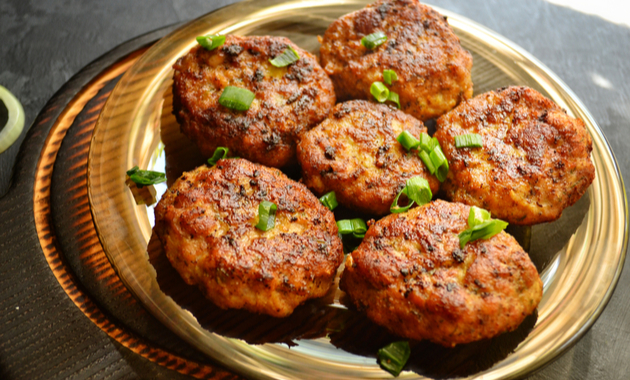
Snacking is a food habit we’re all guilty of. We often find ourselves yearning for something to munch on while the next meal is still a few hours away. Is that urge to munch wrong? Is snacking unhealthy?
The answer is “NO”. Snacking can help satiate your hunger (feeling full for long), thereby preventing overconsumption at the following meals. However, snacking is healthy provided you opt to replace that bag of chips with healthier alternatives like sprouts, fruits, nuts, yogurt, and prunes; which are high in fiber and protein. Studies[1] have shown that including such whole grains in snacks can enhance satiety and promote appetite control to reduce obesity. So here we bring you a recipe that is not only easy on your pocket but also quick-to-make and healthy to satisfy your taste buds.
Moong Sprout And Spring Onion Tikki Recipe
What you need (For 1 serving)
– ⅛ cup parboiled sprouted moong
– 1-2 tsp finely chopped spring onion
– ⅛ tsp finely chopped green chili
– 1-2 tsp oat flour
– Salt (sendha namak or rock salt) to taste
– ⅛ tsp oil for greasing and cooking
Consult our team of expert dieticians to get personalized diet plans as per your needs.
How to prepare
1. Blend the moong to form a coarse mixture without using any water.
2. Transfer the mixture into a deep bowl. Add salt, the remaining ingredients and mix it well.
3. Divide the mixture into equal parts and make medium-sized tikkis of the shape you like.
4. Heat a non-stick tawa and grease it with ¼ tsp oil.
5. Put the tikkis on the tawa and cook till the tikkis turn golden brown.
6. Transfer it to a plate containing a tissue paper to soak extra oil (if any). Serve hot with mint and onion chutney.
P.S.: It is not recommended to include this recipe in the everyday menu. You may consume it occasionally with a cup of warm chai, on a rainy day.
Nutritional facts
1 tikki contains:
– 31 calories
– 4.6 g carbohydrates
– 1.9 g protein
– 0.6 g fat
– 1.4 g fiber
Benefits of this dish
– Moong sprouts are a rich source of protein, minerals, vitamins, dietary fiber and compounds like polyphenols, polysaccharides, and peptides. This makes it highly beneficial for people with diabetes, high blood pressure and cholesterol[2]. If you’re serving it to anyone with high blood pressure, you can replace salt and use a pinch of crushed black pepper or ginger to enhance the taste. Moong sprouts also have antioxidant, antimicrobial, anti-inflammatory and anti-tumor properties[3].
– Spring onions are enriched with Vitamin C, calcium and dietary fiber. They also provide Vitamin B1 (thiamine), folate, Vitamin A, Vitamin B6 and minerals like potassium, copper, chromium, manganese and iron. While buying spring onions, choose the ones with dark green, healthy, and fresh leaves[4].
– Snacks can be your source of energy after you have exercised or in between your meals. Pick foods that are high in fiber and low in fat and sugar. Always stay away from foods that contain added sugar.
Now that you know what exactly your snack time food should include, pledge to choose only healthy items like the moong sprout and spring onion tikki. Happy snacking!
(The article is reviewed by Dr. Swati Mishra, Medical Editor)
Recommended Reads:
9 Unhealthy Habits That Are Slowing Your Metabolism
Are You Just Overeating Occasionally Or Is It Binge Eating Disorder?
Healthy Recipes: Colorful, Nutrient-packed Oriental Asian Salad
References:
1. Valentine Yanchou Njike, Teresa M Smith, Omree Shuval, et al. Snack Food, Satiety, and Weight. Adv Nutr. 2016 Sep; 7(5): 866–878. https://www.ncbi.nlm.nih.gov/pmc/articles/PMC5015032/
2. Dianzhi Hou, Laraib Yousaf, Yong Xue, et al. Mung Bean (Vigna radiata L.): Bioactive Polyphenols, Polysaccharides, Peptides, and Health Benefits. Nutrients. 2019 Jun; 11(6): 1238. https://www.ncbi.nlm.nih.gov/pmc/articles/PMC6627095/#:~:text=To%20date%2C%20the%20mung%20bean,Table%203%20and%20Table%204).
3. Dongyan Tang, Yinmao Dong, Hankun Ren, et al. A review of phytochemistry, metabolite changes, and medicinal uses of the common food mung bean and its sprouts (Vigna radiata). Chem Cent J. 2014; 8: 4. https://www.ncbi.nlm.nih.gov/pmc/articles/PMC3899625/
4. Onions, spring or scallions (includes tops and bulb), raw. Nutrient data listing provided by USDA SR-21.https://nutritiondata.self.com/facts/vegetables-and-vegetable-products/2509/2